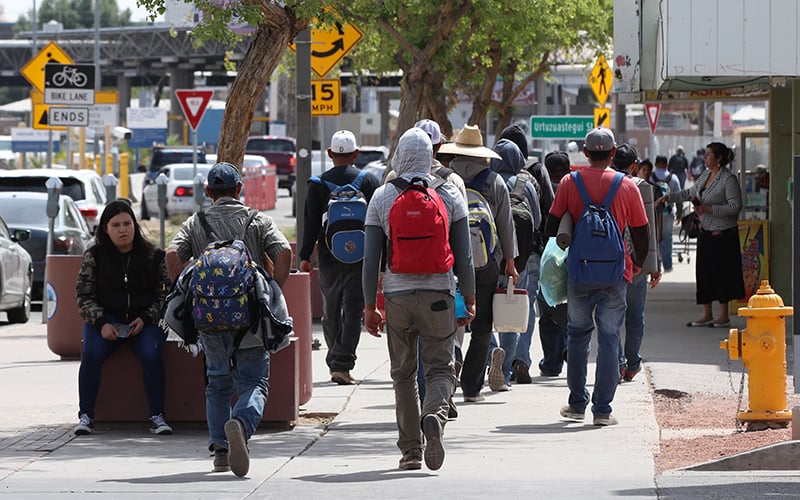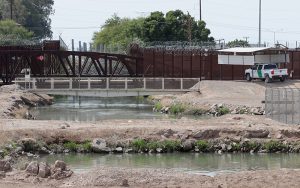
The San Luis Port of Entry in Yuma County is the second busiest pedestrian border crossing in Arizona. Every day, thousands of workers and students cross the U.S.-Mexico border by foot, according to U.S. Department of Transportation statistics. (Photo by Julian Hernandez/Cronkite News)
YUMA – As a congressional and potential legal battle over the reappropriation of $1 billion in military funds to construct 57 miles of new border fencing heats up in Washington, residents and workers in this corner of Arizona expressed mixed emotions over the effectiveness and necessity of additional barriers.
All the while, the number of migrant families being detained along the southern border continues to grow, putting ever more pressure on beleaguered immigration agencies, as well as churches and other groups that assist migrants.
Jose Salazar, 19, works at the Jack in the Box in San Luis, just a couple of blocks away from the U.S.-Mexico border. Salazar, who was raised in Indiana, is working temporarily in San Luis so he can visit his mother while she applies for documents to travel to the United States legally.

Customs and Border Patrol agents closely monitor a section of the border just west of the San Luis Port of Entry where a barrier of concertina wire descends into a canal that crosses into Mexico. (Photo by Julian Hernandez/Cronkite News)
Salazar doubts any new border barriers would stop undocumented immigration into the United States.
“They’re going to find a way regardless. They’re going to get in here,” he said. “It’s wasting money, honestly.”
Even if the United States builds a 50-foot-high wall, rather than the 18-foot-high pedestrian fence the Department of Homeland Security is calling for, “They’re going to get in some way,” Salazar said.
Matthew Scott of Yuma would like to see something done to curb undocumented immigration but said he’s “neutral on it,” referring to the proposed new barriers.
“I believe there is something that should be done about the border, but I’m not really sure if the wall is the right answer overall,” Scott said. “I just know that something should be done to try make things easier to people to get in, but at the same time do something to curb the illegal immigration and the other problems that are going on right now.”
No start date has been set for construction of new fencing around Yuma County, but the arrival of migrants seeking asylum – the majority fleeing poverty and violence in Central America – continues to increase, leaving Customs and Border Protection unable to handle the influx. In past years, most border crossers were young single men seeking work in the U.S., not families with children.
Apprehensions of families crossing the border in the Yuma Sector in fiscal year 2019 have more than doubled over 2018, with 17,578 individuals apprehended with a family member, according to the latest CBP numbers.
The El Paso Sector has seen the largest increase from 2018 to 2019, with agents apprehending 18 times more migrants traveling with family members.
Overall, the increase has left CBP, local organizations and churches in Arizona also stretched to their limits.
So many migrant families have turned themselves into authorities in Yuma County that CBP can’t process them fast enough for deportation. In a Thursday news release, CBP said agents will begin releasing detained migrants into Yuma while they wait for deportation hearings in immigration courts.
“Yuma Sector has experienced a significant rise in the number of family units arrested throughout the sector,” the statement reads. “Due to capacity issues at our stations and the ongoing humanitarian crisis nationwide, Border Patrol has begun identifying detainees for potential release in Yuma with a notice to appear for their immigration hearings.”
Yuma is used to having thousands of people cross the border each day at the San Luis Port of Entry, with border traffic peaking during the winter months when thousands more cross to work at the many farms in the area.
Nearly half of Yuma County’s annual GDP can be attributed to its agriculture sector, which supplies more than 80 percent of all lettuce in the United States during the winter months, according to a 2017 University of Arizona study of the contributions leafy greens have to Arizona’s economy.
Despite the high unemployment rate in Yuma County, which peaks in the summer months at about 20 percent and drops to about 14 percent in peak produce season, local growers continue turn to the H-2A temporary agricultural worker visa program to meet demand as they struggle to find workers locally, according to a 2014 National Center for Farmworker Health report.
It is unknown whether migrants released in the Yuma will stay in the area or experience the same problems seen in Phoenix and face the possibility of being stranded at bus stations.